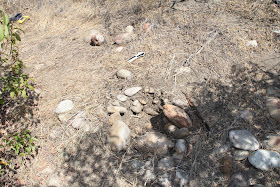I spent last week in California doing a survey for a project we have in the San Diego area. The picture above shows the inland scrub environment of the area. If you look closely you can see an old landslide in the middle of the hillside. Believe me, it was plenty hot there last week.
This was our fourth time to visit the area as the project "footprint" keeps changing. We really hadn't found much of anything in the previous surveys but I did run across a few things this time. In this picture you can see a deflated hearth that is the semicircle of stones near the top of the pic. There is also a stone-lined roasting pit seen as the circle of stones at the edge of the shade near the middle of the picture. There is a 10 cm scale on the north arrow in the picture. We didn't find any artifacts of any sort in the immediate area, which really leaves us stuck for a guess as to whether these are historic or prehistoric in age.
Later, about 10 meters east of the hearth and roasting pit, we found a feature unlike anything I have seen before. There is a natural intermittent drainage running downhill from north to south here. At some time in the past, someone had worked their way down the drainage taking cobbles out of the bottom of the channel, and stacking them on either bank. You can see the north arrow/scale in the bottom of the channel in this picture. Where the channel curves, cobbles are stacked on the outside of the curve to reinforce the bank.
This goes on for a stretch of about 130 meters, ending abruptly about 30 meters south (and downhill) from the hearth and roasting pit. As I went downhill, I kept expecting this to end in some sort of dam and pool arrangement to trap the water flow increased by deepening the channel, but it just stopped. It doesn't connect with anything. It appears to have been done by hand, and as with the hearth and roasting pit, there were no artifacts found. I assume all of these features are related.
We frequently find and record lots of irrigation channels and other ditch-like features, but I have never seen a natural drainage modified this way. Quite a mystery, and so far no way to date it. None of the historic documents related to the area give us any clue as to what this might represent.
Several hundred meters from these features, we did find a single isolated prehistoric artifact, this quartzite secondary flake. No indication of use-wear on it. Looks like it just fell out of somebody's pocket.




No comments:
Post a Comment
Note: Only a member of this blog may post a comment.